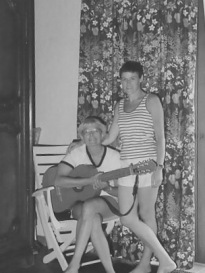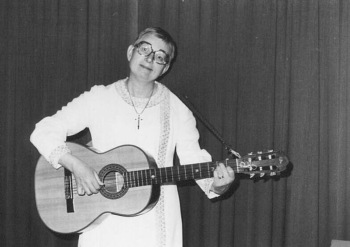Jeanne-Paule “Jeanine” Marie Deckers, famously known as ‘The Singing Nun’, was born in Belgium on October 17, 1933. Her parents owned a bakery in Brussels and hoped Jeanine would one day take over the family business. Instead, she enrolled in art school in Paris which she attended only briefly; After a nervous breakdown prompted by a failed engagement, Jeanine dropped out of school and joined the Dominican Fichermont Convent near Waterloo in 1959 at the age of twenty-six. There, she made a vow of poverty and took the name ‘Sister Luc-Gabrielle’. For the first time Jeanine Deckers, who had had a self-described “loveless” childhood, felt like she was part of a family. She had written songs from an early age and was allowed to keep her beloved guitar which she had named ‘Sister Adele’.
At the convent, she wrote and sung folk songs about Catholic saints. The nuns were so impressed with Jeanine’s talents, they encouraged her to make a limited press album which could be sold at religious retreats and to visitors of the convent to raise money for the order’s mission in the Congo.In October of 1961, with the support of convent leaders, Jeanine Deckers recorded her first album in the Phillips Recording Studio in Brussels. An executive at the studio heard Jeanine’s songs and convinced the order to allow commercial distribution of the record. Jeanine signed a contract with Philips Recording under, ‘Soeur Sourire’, a stage name chosen by the church; In English, the name translates to ‘Sister Smile’. In 1963 a song by Jeanine Deckers about the 13th century founder of the Dominican order was released in Belgium as a single. To Jeanine’s surprise, the song, ‘Dominique’ (which many of you may remember as the French song played repeatedly throughout American Horror Story: Asylum) quickly became a number one hit in Belgium.
Dominique‘s popularity spread; The song rose to #1 throughout Europe, even in areas where French was not a predominant language. By December of 1961 Dominique-mania hit America where the single by “The Singing Nun” held at number one on the charts for three weeks; To this day, Jeanine Deckers is the only Belgium to have released a #1 single in the United States. Between 1963-1964 the song was on the charts in eleven different countries and was ranked higher than songs released by The Beatles and Elvis Presley. The French song was re-recorded in Dutch, German, Japanese and Hebrew. Jeanine went on a world tour as ‘Soeur Sourire’ and even appeared on The Ed Sullivan Show despite disapproval from her Mother Superior. Jeanine Deckers’s album Her Joy, Her Songs sold over two million copies; Having taken a vow of poverty when she joined the Dominican order, all of Jeanie’s profits went directly to the convent. In 1966 The Singing Nun, a highly fictionalized American movie about Deckers’s life and career in the convent starring Debbie Reynolds was released.
By this time, Deckers had retreated from the public eye and began to question many of the Catholic church’s teachings. Jeanine, who thought The Singing Nun to be an “absolutely idiotic” movie, resented the attention Dominique‘s fame had brought to her.

‘The Singing Nun’, 1966
Jeanine had first met Annie while working as a camp counselor in her youth. Annie, who was eleven years younger than Decker, was attending the camp and quickly became infatuated with Jeanine; Of course, Jeanine did not appreciate the attention. When Annie became an adult, she made a point to live near Jeanine and would often visit her at Fichermont Convent. Allegedly, at one time, when it seemed as though Jeanine was to be sent to another country on missionary work where Annie could not follow, Annie attempted to commit suicide. In 1968 Jeanine Deckers released a new album and planned a tour throughout Canada. This album, in contrast to Her Joy, Her Songs, expressed many of Jeanine’s anti-Catholic views and included a song entitled ‘Sister Smile is Dead’. The most inflammatory song on the album, ‘Glory Be to God For the Golden Pill’, expressed Jeanie’s pro-birth control views.
Jeanine’s feministic views which were contrary to those of the Catholic church, caused a mass amount of controversy. The Canada tour ended abruptly when an audience in Quebec was horribly offended by Deckers’s new, anti-Catholic lyrics.
Due to this, as well as rumors that Jeanine and Annie were in a lesbian relationship, they were both ousted from the Catholic church. The two promptly moved into an apartment together; While the exact nature of their relationship at this time is unclear, allegedly, Jeanine initially told Annie she did not want a sexual relationship with her.According to Annie’s diaries, however, that changed over the years as the two eventually fell in love. A friend of the couple claimed that Ann was extremely possessive of Jeanine and that she had less freedom during their relationship than she did while living at the convent. In the 1970s, Jeanine Decker shared in an interview that she owed $63,000 in back taxes from her record sales. Having donated all the money directly to the church, she asked her former convent that had profited off her talents to pay the taxes she owed the Belgian government. The order refused to pay, claiming the small convent was financially troubled itself and did not have the funds. She engaged in a lengthy legal battle against Belgian tax authorities but unfortunately, there was not a proper paper trail to prove her earnings had been donated to the Dominican order. In an attempt to pay back the debt, Jeanine tried to restart her musical career.
 She released an album of religious and secular children’s songs called I Am Not a Star in Heaven under the name “Luc-Dominique”; Allegedly, this was because the church owned the rights to the name ‘Soeur Sourire’ however, Jeanine confessed she had come to hate that name. In 1982, Jeanine Deckers lost her final case against the Belgian tax authorities and was ordered to pay the $63,000 in back taxes. Later that year she recorded a synthesized, disco version of Dominique and released a music video in a second attempt to raise the $63,000 she owed; This only drove her further into debt.
She released an album of religious and secular children’s songs called I Am Not a Star in Heaven under the name “Luc-Dominique”; Allegedly, this was because the church owned the rights to the name ‘Soeur Sourire’ however, Jeanine confessed she had come to hate that name. In 1982, Jeanine Deckers lost her final case against the Belgian tax authorities and was ordered to pay the $63,000 in back taxes. Later that year she recorded a synthesized, disco version of Dominique and released a music video in a second attempt to raise the $63,000 she owed; This only drove her further into debt.

Jeanine & Annie at the school in Wavre.
Over the years, Jeanine had become addicted to the medication prescribed for her anxiety. As Jeanine sunk into a severe depression due to her financial state, she became completely depended on tranquilizers and alcohol. According to Annie, Jeanine was having, “nervous breakdown after nervous breakdown.”.
In 1983, Jeanine and Annie opened a small boarding school for Autistic children in Wavre, Belgium which brought both of them great joy. Sadly, they were forced to close the school in 1985. After the school closed, Jeanine Deckers and Annie Pecher decided to enact a suicide pact. On March 29, 1985 Jeanine and Annie killed themselves in the apartment they shared in Wavre by taking a large dose of barbiturates with alcohol.
 Their bodies were discovered on April 1st in unit 47B of the Green Horizons Apartment Building at 144 Chaussee de Bruxelles. Anne left a suicide note explaining that the closing of the school and their massive debt were the primary reasons behind the double suicide. She stated in the note that she and Jeanine had not lost their faith and would like a church funeral. They also asked to be buried together and requested “privacy” [regarding the nature of their relationship] from the investigators who would discover their bodies. In the note, Annie wrote, “We have reached the end, spiritually and financially and now we go to God… We go to eternity in peace. We trust that God will forgive us. He saw us both suffer and he wont let us down. It would please Jeanine not to die from the world. She had a hard time on earth. She deserves to live in the minds of the people.”.
Their bodies were discovered on April 1st in unit 47B of the Green Horizons Apartment Building at 144 Chaussee de Bruxelles. Anne left a suicide note explaining that the closing of the school and their massive debt were the primary reasons behind the double suicide. She stated in the note that she and Jeanine had not lost their faith and would like a church funeral. They also asked to be buried together and requested “privacy” [regarding the nature of their relationship] from the investigators who would discover their bodies. In the note, Annie wrote, “We have reached the end, spiritually and financially and now we go to God… We go to eternity in peace. We trust that God will forgive us. He saw us both suffer and he wont let us down. It would please Jeanine not to die from the world. She had a hard time on earth. She deserves to live in the minds of the people.”.

Jeanine Deckers and Annie Pecher were buried together in the Cheremont Cemetery in Wavre, Belgium. An inscription on their tomb reads, “J’ai vu voler son ame/A travers les nuages”. It is a line from Jeanine’s song Sister Smile is Dead and in English translates to, “I saw her soul fly across the clouds”.
Please Help The Post-Mortem Post by Donating $1 to Improve the Website
Follow @PostMortem_Post on Twitter and Like us on Facebook!
If you enjoyed this article, you might also like The Most Beautiful Suicide, Pray the Decay Away: Incorruptible Corpses and Other Forms of Natural Postmortem Preservation, Is Kicking the Bucket for Catholics Only?, and ‘Til Death Do We Part: Couple Married 60 Years Buried in Double Coffin































